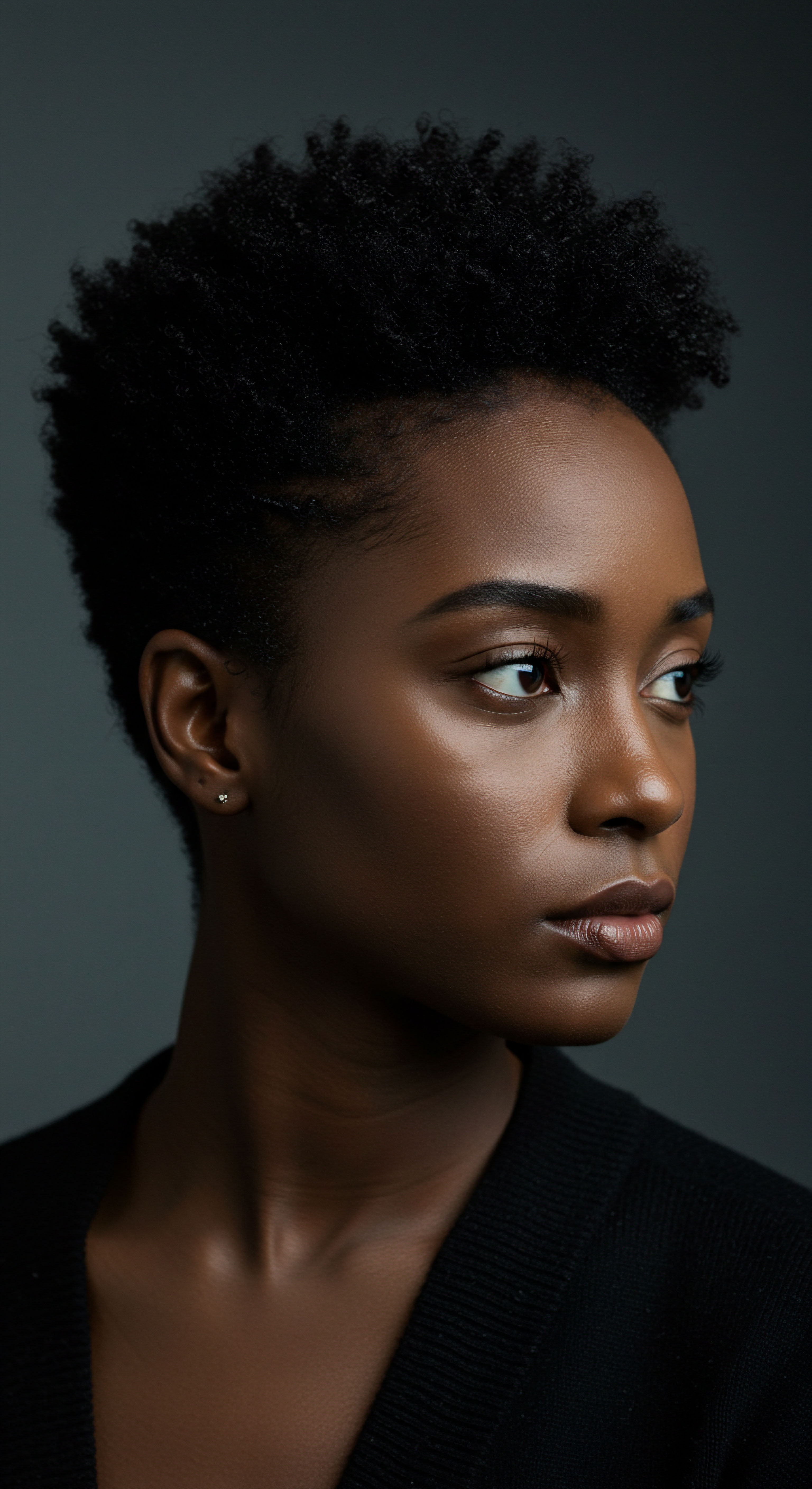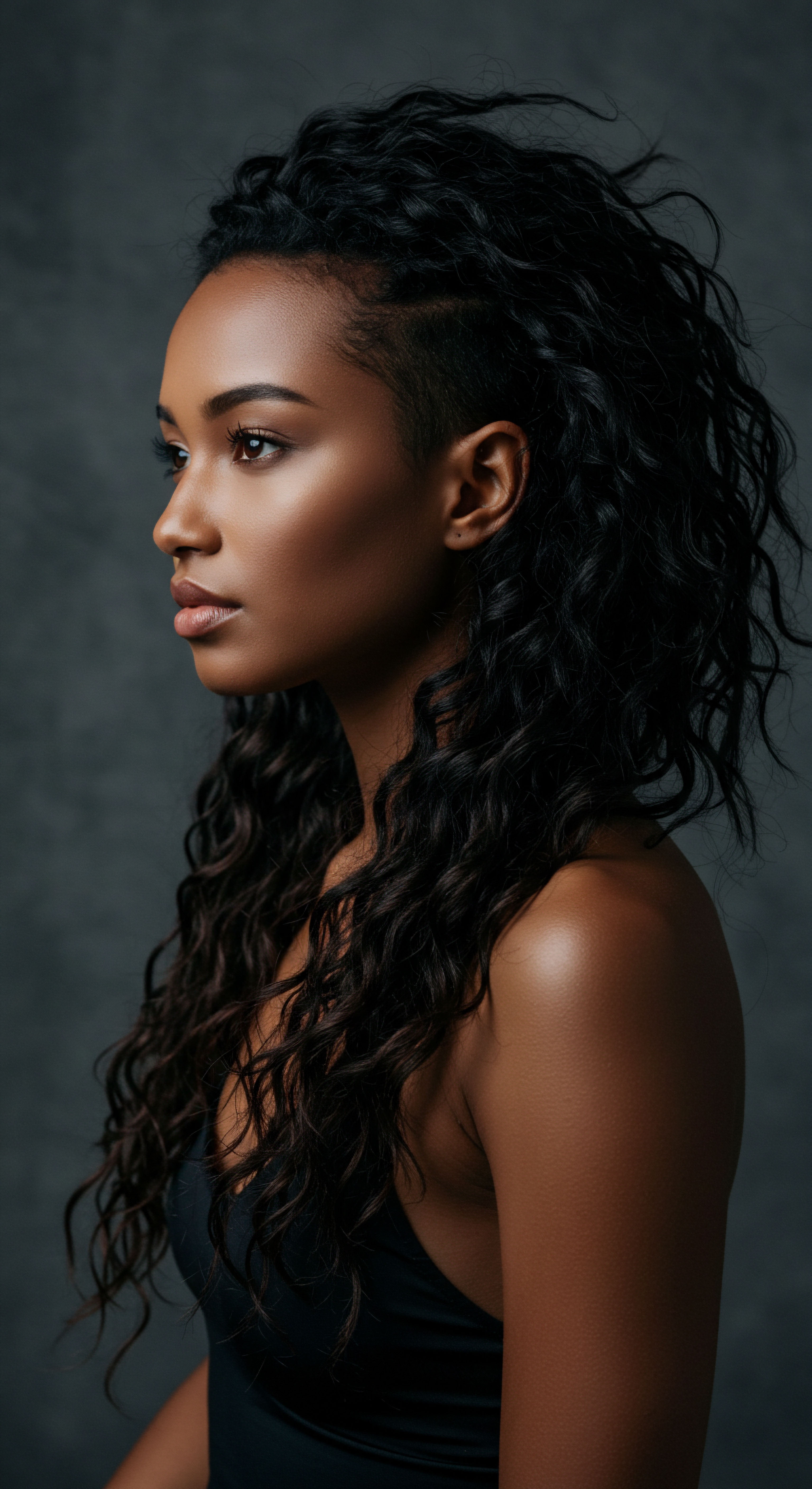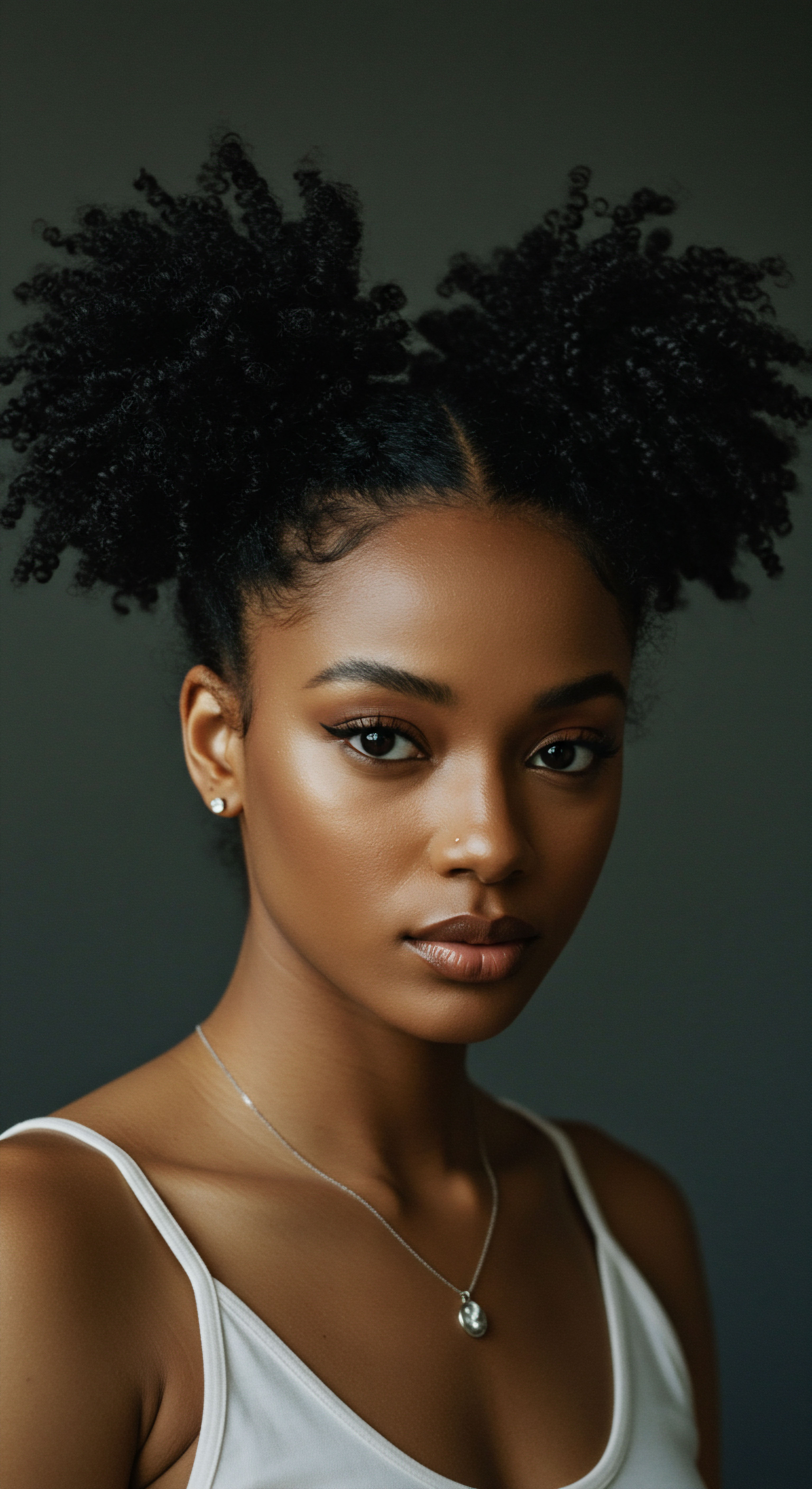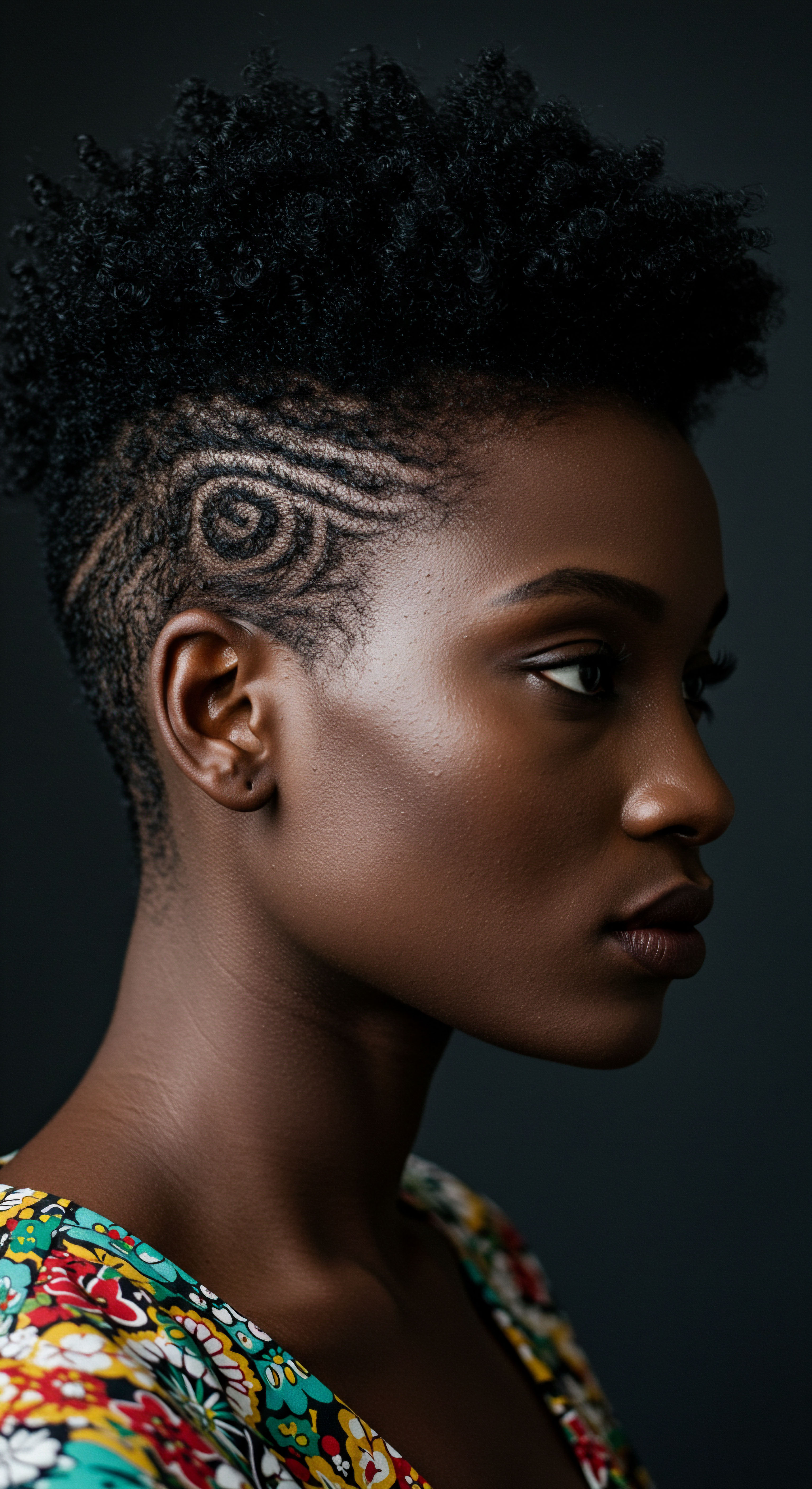
Roots
Consider for a moment the quiet whisper of ancestry in a single strand of hair. It is a subtle yet profound connection, reaching back through generations, carrying stories and identities long before we ever learned to braid or twist. Our hair, particularly textured hair, holds within its very structure a history that extends beyond personal style, reaching into the deep wellspring of human culture and collective memory. This physical attribute, so often seen as merely cosmetic, is in truth a vibrant chronicle, reflecting ancient societal structures, spiritual beliefs, and the resilient spirit of peoples across the globe.
The journey of understanding how hair care rituals shape who we perceive ourselves to be begins with recognizing hair not as an inert fiber, but as a living archive. From the earliest communal grooming sessions to the quiet moments of personal reflection before a mirror, the way we tend to our hair carries echoes of practices that once signified status, marital state, or even tribal affiliation. These rituals, passed down through whispers and hands-on lessons, formed a language of identity, a visual lexicon understood by communities without a single spoken word.

Hair’s Earliest Expressions of Selfhood
Across ancient civilizations, hair was rarely left to its own devices. Its styling served as a powerful non-verbal communication system, a testament to its wearer’s place within the societal fabric. For instance, among many African communities, intricate hairstyles could signify age, wealth, marital status, or even a particular tribal affiliation.
This meant that a glance at a person’s head could convey a wealth of personal information, acting as a social passport. The very act of caring for and adorning hair was a communal activity, strengthening bonds and reinforcing shared cultural values.
Hair, in its varied forms and careful adornments, has always spoken volumes about a person’s place within their community.
These early practices highlight a foundational truth ❉ hair, and the care given to it, was deeply integrated into the human experience, far beyond mere aesthetics. It was a canvas for collective identity, a symbol of belonging, and a marker of individual journey within a larger group. The meticulous attention paid to hair was a form of self-respect, a way to honor one’s heritage and position.

The Biology of Identity’s Strands
Beyond its cultural resonance, the physical nature of hair itself plays a part in this story of identity. Hair is a complex biological structure, emerging from follicles nestled beneath the skin. Its unique characteristics—curl pattern, density, porosity—are determined by genetics, a biological blueprint passed down through generations. For individuals with textured hair, these inherent qualities dictate specific care needs, shaping routines from cleansing to moisturizing and styling.
- Hair Follicle Shape ❉ The shape of the hair follicle opening influences the curl pattern; an oval or elliptical follicle produces curlier hair, while a round follicle produces straight hair.
- Cortical Cells ❉ The distribution of cortical cells within the hair shaft also contributes to curl, with uneven distribution causing the hair to coil.
- Moisture Retention ❉ The unique structure of textured hair often means it has a raised cuticle layer, making it more prone to moisture loss and requiring specialized hydration strategies.
Understanding these biological underpinnings provides a scientific lens through which to appreciate the diversity of textured hair. It helps explain why certain care methods work for some hair types and not others, moving beyond anecdotal advice to a more grounded, informed approach. This scientific literacy empowers individuals to truly understand their hair’s inherent qualities, fostering a deeper connection to their own biological makeup and, by extension, their personal heritage.
This scientific appreciation also underpins a sense of self-acceptance. When one comprehends the biological reasons for a particular curl or coil, the tendency to view it through the narrow scope of imposed beauty standards lessens. Instead, a celebration of its unique properties can flourish, transforming care routines into acts of scientific discovery and personal affirmation.

Hair’s Shifting Semiotics Across Time
The meaning attributed to hair has not remained static; it has shifted with historical currents, societal norms, and political movements. For communities of African descent, this historical trajectory is particularly poignant. During periods of oppression, hair became a site of profound struggle, often subjected to attempts at erasure or alteration to conform to dominant beauty ideals. The forced shaving of heads during the transatlantic slave trade, for example, was a deliberate act to strip individuals of their cultural markers and communal bonds.
Conversely, periods of cultural resurgence have seen hair reclaim its position as a powerful symbol of defiance and pride. The “Black is Beautiful” movement of the 1960s, for instance, saw a widespread embrace of natural Afro styles, which became a potent visual manifestation of self-acceptance and a challenge to Eurocentric beauty standards. This historical ebb and flow demonstrates how hair, far from being merely a personal choice, can become a deeply politicized aspect of identity, reflecting broader societal tensions and aspirations. Understanding these historical layers helps illuminate the weight and meaning that hair care rituals carry for many individuals today.

Ritual
The quiet moments spent tending to our hair are more than simple tasks; they are ceremonies of self, imbued with personal meaning and a rhythmic cadence. These routines, whether a weekly wash day or a daily conditioning, extend beyond the functional, becoming acts of self-connection and creative expression. They offer a pause in the rush of daily life, a chance to connect with our physical selves, and to shape the outward presentation of our inner world. This section explores the profound impact of these recurring practices, moving beyond the mere application of products to the deeper psychological and social dimensions they hold.
Each carefully chosen product, every gentle stroke of a comb, and the patience required for intricate styling contribute to a personal narrative. For those with textured hair, these rituals often involve a heightened level of dedication, a testament to the unique needs of curls, coils, and waves. This dedication transforms routine into ritual, fostering a sense of discipline and mindfulness that resonates deeply with one’s perception of self.

The Psychology of Hair Care Moments
The act of caring for hair holds a remarkable psychological sway. Research indicates a strong connection between hair grooming practices and self-esteem. A study published in the Journal of Applied Social Psychology found that individuals who received a compliment on their appearance, including their hair, felt more confident and capable in subsequent tasks. This suggests that the outward appearance of our hair, shaped by our rituals, directly influences our inner state of mind.
The intentional acts of hair care can elevate personal confidence and shape one’s inner narrative.
Consider the simple pleasure of a well-executed wash day ❉ the cleansing, the conditioning, the styling that brings curls to life. These small victories contribute to a positive self-image, fostering a sense of accomplishment and control over one’s appearance. Conversely, periods of stress or insecurity can sometimes manifest as neglect of hair care, signaling an internal need for change or support. The mirror, during these moments, reflects not just hair, but the emotional landscape within.
Moreover, the choices made during these rituals — from selecting specific products to opting for a particular style — are rarely arbitrary. They often mirror our emotional state or the identity we wish to project. Psychological studies indicate that hair transformations frequently coincide with significant life transitions, such as starting a new career or embarking on a period of personal growth, serving as a visible assertion of a shifting self. The hair ritual, therefore, becomes a conscious and unconscious dialogue between our inner world and our outer presentation.

What Messages Do Our Hair Choices Send?
Our hair choices are potent communicators, conveying messages about our personality, affiliations, and values. A sleek, polished style might convey meticulousness and order, while a free-flowing, textured look could speak to spontaneity and independence. These choices extend beyond individual preference, often reflecting broader cultural currents and societal expectations.
For those with textured hair, this communication carries additional layers of meaning. Historically, certain styles were adopted to align with dominant beauty standards, often requiring extensive manipulation. Today, the choice to wear natural textures openly can be a powerful statement of cultural pride and self-acceptance, a visible rejection of past pressures. This shift highlights the active role individuals play in shaping their identity through hair, transforming historical burdens into celebrations of heritage.
| Hair Style or Practice Natural Hair Movement |
| Potential Societal Reflection Cultural pride, anti-conformity, authenticity |
| Personal Identity Link Self-acceptance, connection to heritage |
| Hair Style or Practice Protective Styles (Braids, Locs) |
| Potential Societal Reflection Cultural continuity, self-care, longevity |
| Personal Identity Link Patience, preservation, heritage expression |
| Hair Style or Practice Chemically Altered Hair |
| Potential Societal Reflection Historical conformity, perceived professionalism |
| Personal Identity Link Adaptation, sometimes a desire for ease |
| Hair Style or Practice These interpretations can vary greatly by individual experience and context. |
The decision to embrace natural textures, for instance, can be a profound act of self-love. It can represent a journey of rediscovering one’s authentic self, moving away from externally imposed ideals towards an inner sense of beauty. This personal quest is often supported by communities that share similar experiences, creating spaces where natural hair is celebrated and nurtured.

The Shared Ritual ❉ Community and Belonging
Hair care rituals, while often solitary, also possess a strong communal dimension. Shared experiences around hair, from childhood braiding sessions to salon visits, foster a sense of belonging and collective identity. These moments can serve as informal learning environments, passing down techniques, traditions, and stories. The salon, for many, transcends its commercial purpose, becoming a social hub, a place of shared conversation, laughter, and mutual support.
Within these communal spaces, individuals often find validation and understanding for their hair journeys. The exchange of tips, the shared frustrations over a difficult style, and the collective admiration for a successful outcome all contribute to a feeling of solidarity. This shared experience strengthens personal identity by affirming that one’s struggles and triumphs with hair are not isolated, but part of a larger, supportive community. The ritual extends beyond the individual, becoming a collective act of affirmation.

Relay
How do the deeper currents of societal expectation and historical legacy intersect with the seemingly private world of hair care rituals, shaping who we are and how we are perceived? This section delves into the intricate interplay of biology, psychology, and culture, revealing how hair care practices become a powerful lens through which identity is not merely expressed, but actively constructed and contested. We move beyond the personal sphere to examine the broader systems that influence our hair journeys, often in ways that are subtle yet profoundly impactful.
The strands on our heads carry more than just genetic code; they bear the weight of history, the whispers of societal norms, and the echoes of collective experience. For individuals with textured hair, this resonance is particularly strong, as their hair has frequently been at the center of discussions around beauty, professionalism, and cultural acceptance. Understanding this deeper context illuminates why hair care is rarely a neutral act, but rather a loaded gesture within a complex social landscape.

Hair Politics and Societal Pressure
The influence of hair care rituals on personal identity is profoundly shaped by the politics of hair, particularly for Black women. Despite growing acceptance of natural hair, societal pressures and discriminatory practices persist. A concerning finding from the CROWN 2023 Research Study indicates that 41% of Black Women Felt Compelled to Alter Their Hair from Curly to Straight for Job Interviews, with 54% Believing Straight Hair was Necessary for Such Occasions.
This data reveals a persistent expectation to conform to Eurocentric beauty standards, even when those standards contradict natural hair textures. Greene (2012) further highlighted that Black women’s hair is 2.5 times more likely to be perceived as unprofessional.
Hair care choices can reflect a delicate balance between personal expression and the subtle, often unstated, demands of societal conformity.
This pressure extends beyond the workplace, reaching into educational settings and public spaces. Research by Mbilishaka (2020) on hair discrimination within Black communities found that both Black women and men experienced interpersonal rejections early in their lives, both within their families and in public settings like schools. These experiences often resulted in sadness, embarrassment, and anxiety, shaping their self-perception and sense of belonging. Such instances illustrate how hair, a seemingly personal attribute, becomes a site of social negotiation and, at times, systemic exclusion.
The psychological impact of these experiences is substantial. Adenique Lisse’s research from UConn found that for Black adolescent girls, hair was the only area of physical appearance satisfaction where differences emerged along racial lines. She noted that Black adolescent girls were significantly more likely than their white and Latina peers to experience hair-related dissatisfaction and discrimination, which in turn correlated with increased feelings of depression. This specific data point underscores how external judgments about hair can deeply wound self-esteem and contribute to mental well-being challenges.

How Do Hair Rituals Become Acts of Resistance?
In response to these pressures, hair care rituals have historically served as powerful acts of resistance and self-assertion. The choice to wear natural textures, particularly in the face of societal disapproval, becomes a visible declaration of self-acceptance and cultural pride. This is not merely a stylistic preference; it is a conscious reclaiming of identity.
The modern natural hair movement, supported by social media, has played a significant part in redefining beauty norms. It has created spaces for individuals to share their hair journeys, exchange knowledge, and collectively challenge the narratives that once devalued their natural textures. This collective action transforms personal hair care into a broader cultural movement, where individual choices contribute to a larger tapestry of self-affirmation.
The journey of transitioning from chemically straightened hair to natural textures, for many Black women, represents a process of identity negotiation. This involves not only learning new hair practices but also redefining one’s understanding of beauty and professionalism. It can be a deeply personal quest for authenticity, often accompanied by a sense of liberation and renewed connection to heritage.

The Intergenerational Language of Hair Care
Hair care rituals are often passed down through generations, forming an intergenerational language that transmits cultural knowledge and familial bonds. From mothers braiding their daughters’ hair to communal styling sessions, these moments are rich with storytelling and shared wisdom. Sybille Rosado (2003) speaks of a “grammar of hair,” suggesting that hair styling acts as a means of communication within the African diaspora, sustaining the transfer of cultural practices.
- Shared Techniques ❉ The practical skills of detangling, conditioning, and styling are taught through hands-on experience, preserving methods unique to textured hair.
- Oral Histories ❉ During hair care sessions, stories of family, community, and historical struggles are recounted, connecting individuals to their lineage.
- Cultural Values ❉ Lessons about patience, self-care, and the significance of one’s appearance are implicitly conveyed, shaping a younger generation’s understanding of their identity.
These intergenerational exchanges do more than simply teach styling techniques; they instill a sense of belonging and continuity. They reinforce the idea that one’s hair is not an isolated feature, but a living connection to a rich cultural heritage. The quiet strength found in these shared rituals helps individuals navigate external pressures, providing a grounded sense of self that resists external definitions.

Hair as a Personal Canvas for Self-Definition
Beyond cultural and societal influences, hair care rituals serve as a deeply personal canvas for self-definition. The conscious decisions about how to style one’s hair become an active assertion of individuality within a broader cultural context. This can involve experimenting with different looks, adopting bold colors, or choosing styles that challenge conventional norms.
For some, hair becomes a vehicle for expressing a fluid or evolving identity. A sudden change in hairstyle might signal a new chapter in life, a release from past constraints, or a desire to project a different aspect of one’s personality. This continuous interplay between self-perception and outward presentation highlights the dynamic nature of identity, with hair serving as a tangible, malleable medium for this ongoing exploration. The ritual of care, therefore, is not a static practice but a living, breathing part of this personal narrative, reflecting growth, change, and an ever-deepening understanding of self.

Reflection
The journey through hair care rituals reveals a landscape far richer than mere aesthetics. It unveils a profound connection between the strands on our heads and the very core of who we are, individually and collectively. From ancient practices rooted in community and status to modern affirmations of heritage and self-worth, hair care is a language of identity, a silent yet potent dialogue between our inner world and the outer one. It is a testament to resilience, a canvas for expression, and a consistent reminder that beauty, in its most genuine form, begins with understanding and cherishing one’s own unique story, one strand at a time.

References
- Byrd, A. & Tharps, L. (2014). Hair Story ❉ Untangling the Roots of Black Hair in America. St. Martin’s Griffin.
- Weitz, R. (2004). Rapunzel’s Daughters ❉ What Women’s Hair Tells Us about Women’s Lives. Farrar, Straus and Giroux.
- Stenn, K. (2016). Hair ❉ A Human History. Pegasus Books.
- Mbilishaka, A. M. (2020). Don’t Get It Twisted ❉ Untangling the Psychology of Hair Discrimination Within Black Communities. American Journal of Orthopsychiatry, 90(5), 590–599.
- Lisse, A. (2025). Hair satisfaction and mental well-being in adolescent girls. Body Image.
- Rosado, S. (2003). The Grammar of Hair. Journal of Black Studies.
- Sieber, R. & Herreman, F. (2000). Hair in African Art and Culture. Museum for African Art.
- Maharaj, C. (2025). Beyond the roots ❉ exploring the link between black hair and mental health. TRIYBE.
- Greene, L. (2012). Hair politics and professional identity. (Specific publication not provided in snippet, general attribution to Greene’s work).
- CROWN 2023 Research Study. (Source attributed in snippet, full publication details not provided).
- McBride, S. G. (2025). Whiskerology ❉ The Culture of Hair in Nineteenth-Century America. Harvard University Press.